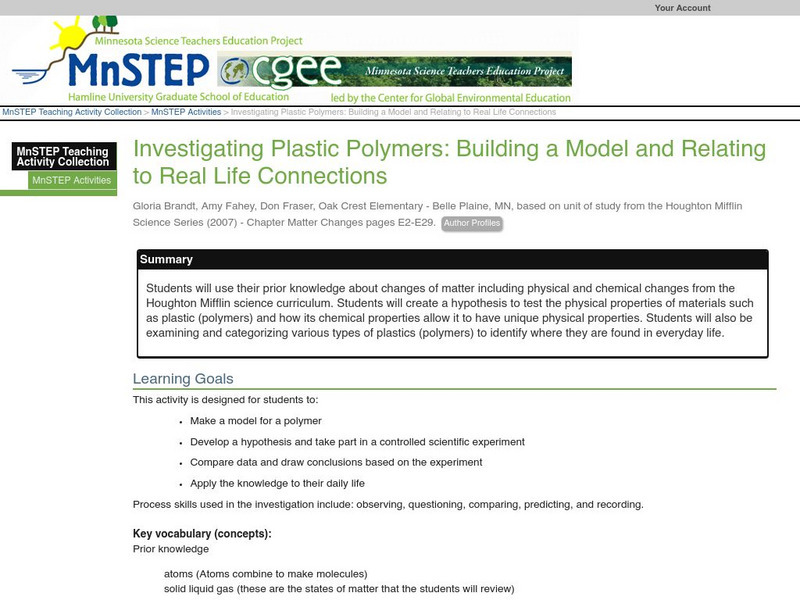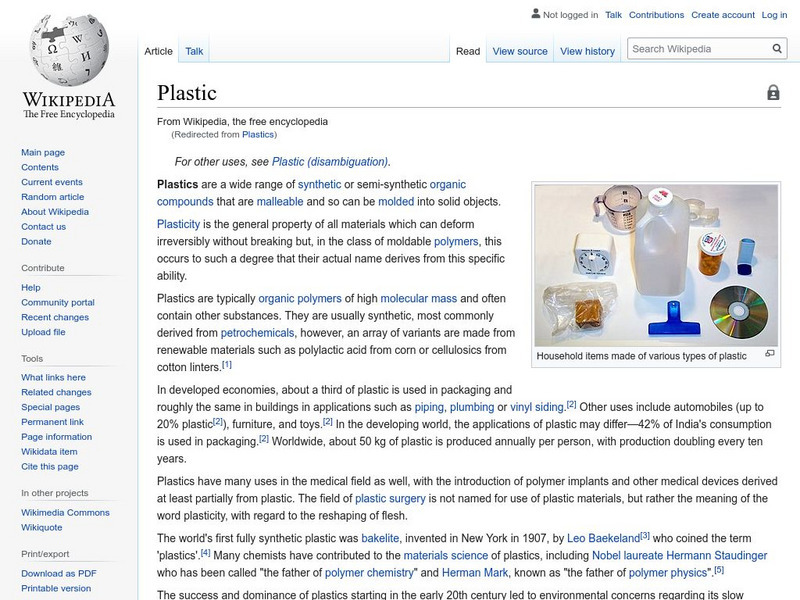Hi, what do you want to do?
Curated OER
Float Your Boat
Young scholars investigate buoyancy, displacement and density. For this flotation lesson students study the Archimedes' Principle, analyze data and draw conclusions.
Curated OER
Observations and Inferences
Young scholars observe how to distinguish observations form inferences. In this examining inferences lesson students list observations relating to the activity and discuss the importance of them.
Curated OER
Specific Gravity-The Relative Density of Liquids
Students explore a hydrometer. In this gravity lesson students construct a hydrometer and create a liquid density column.
Curated OER
Watching Crystals Grow
Students observe crystal growth of Epsom salts and the variables that hinder or help their nucleation and growth. They illustrate a series of drawings/pictures as the crystals grow. They look for the different shapes they form as well...
Curated OER
Measuring Magnetic Field Strengths Using Ferrofluids
Students explore the field of nanotechnology by examining magnetic field strength in ferrofluids. They use probes attached to a computer program to determine the relationship between magnetic field strength and magnetic field lines.
Curated OER
Condiment Diver: The World's Simplest Cartesian Diver
Students examine buoyancy. In this density lesson students form a hypothesis, collect data and draw a conclusion using the data.
Curated OER
Heat Loss and Gain in Physical Changes and Chemical Reactions
Students measure the heat of physical and chemical changes in reactions. In this chemistry lesson students determine at what extent changes emit or absorb heat.
Curated OER
How Creepy!
Students observe and measure a model of slow down slope movement. In this graphing instructional activity students collect, record, and organize data that apply to models.
Curated OER
The Glass House - Farnsworth House, Plano, Illinois
Students analyze the architecture of Ludwig van der Rohe's 'The Glass House.' In this architecture analysis lesson plan, students view the images of the house and read about the home. Students complete two research projects for the...
Curated OER
Analagous Colors
Students encounter how to mix analogous colors and use them in cane patterns. They select two colors that are next to each other on the color wheel. Students then knead the pieces for a couple of minutes and then roll each color into a...
Curated OER
Breaking Beams
Students work together designing and building their own beams. They discover the concepts of stress and strain. They participate in a competition to determine the best beam.
Science Education Resource Center at Carleton College
Serc: Investigating Plastic Polymers: Building a Model
Students will use their prior knowledge about changes of matter including physical and chemical changes from the Houghton Mifflin science curriculum. Students will create a hypothesis to test the physical properties of materials such as...
Science Education Resource Center at Carleton College
Serc: Mn Step: Where in the World Can I Find Plastic Polymers. Why Are They Used?
An investigation of where plastic polymers can be found in everyday life. After identifying them, students test them to learn about their properties, then try some online activities.
Science Education Resource Center at Carleton College
Serc: Plastic Polymers: Investigating Their Flexibility
Students will use their prior knowledge about changes of matter to develop a hypothesis to test the physical properties of materials such as plastic (polymers) and how its chemical properties allow it to have unique physical properties.
TeachEngineering
Teach Engineering: Close Encounters of the Polymer Kind
Students explore the basic characteristics of polymers through the introduction of two polymer categories: thermoplastics and thermosets.
Concord Consortium
Concord Consortium: Stem Resources: Plastic Forces
This simple interactive tool lets students explore what happens to the long molecular chains in a plastic polymer material when forces of varying intensity are exerted on it.
Science Education Resource Center at Carleton College
Serc: Polymers & Plastics: Classification & Models
Young scholars will use their prior knowledge about changes of matter including physical and chemical changes to examine and categorize various types of plastics (polymers). They will identify how their chemical properties allow them to...
TeachEngineering
Teach Engineering: Bridging to Polymers: Thermoset Lab
Students act as engineers to learn about the strengths of various epoxy-amine mixtures, and observe the unique characteristics of different mixtures of epoxies and hardeners. Student groups make and optimize thermosets by combining two...
Other
American Chemistry Council: History of Polymer and Plastics for Students
This resource presents a brief guide introduces the history, structure, and characteristics of plastics and polymers.
Practical Action
Practical Action: Plastics Challenge
This is a challenge for students to develop solutions to the problems caused by plastic waste globally. They will learn about how plastic waste impacts people around the world, the different types of plastic, how they are each used, how...
Other
American Chemistry Council: History of Polymers & Plastics for Teachers
This resource presents a teacher guide that offers information on the history, structure, characteristics, forms, and common uses of plastics and polymers.
TED Talks
Ted: Ted Ed: From Dna to Silly Putty, the Diverse World of Polymers
Polymers occur both naturally- our DNA is a polymer- and synthetically, like plastic, Silly Putty, and styrofoam. Jan Mattingly explains how polymers have changed our world. [4:59]
Wikimedia
Wikipedia: Plastic
Wikipedia offers all of the basic information one would need about the topic of plastic. Includes hyperlinked table of contents for easy site navigation.
Maryland Science Center
Maryland Science Center: Milk Plastic [Pdf]
A simple experiment to create a chemical reaction between milk and vinegar, with the product being a type of plastic.




























![Maryland Science Center: Milk Plastic [Pdf] Activity Maryland Science Center: Milk Plastic [Pdf] Activity](https://static.lp.lexp.cloud/images/attachment_defaults/resource/large/FPO-knovation.png)